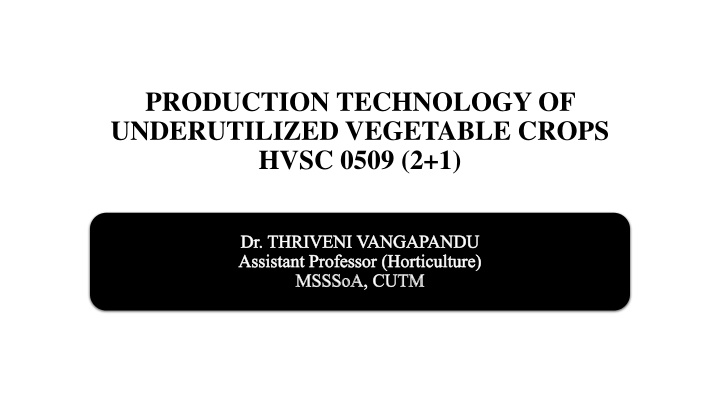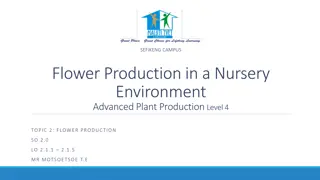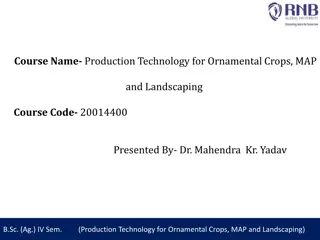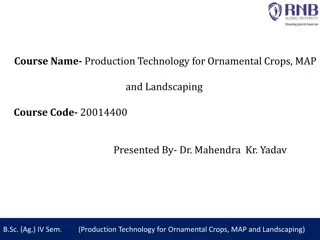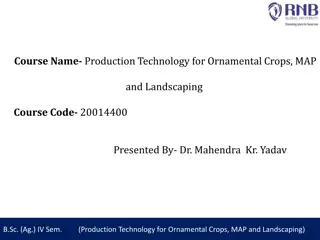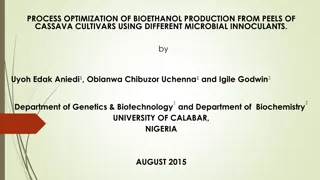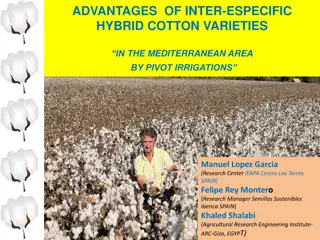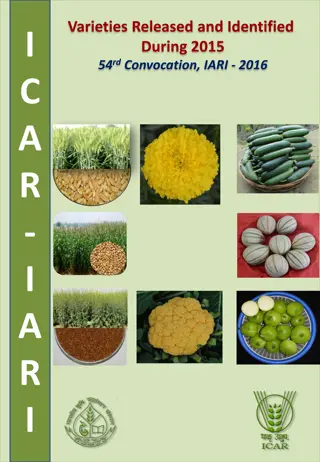Production Technology of Sweet & Baby Corn Varieties and Cultivars Overview
Introduction to the production technology, nutritive value, and classification of sweet and baby corn varieties and cultivars. Covers the origin, types of corn, and specific cultivars developed in India with characteristics and utility. Includes information on nutritive values and cultivation regions.
Download Presentation

Please find below an Image/Link to download the presentation.
The content on the website is provided AS IS for your information and personal use only. It may not be sold, licensed, or shared on other websites without obtaining consent from the author.If you encounter any issues during the download, it is possible that the publisher has removed the file from their server.
You are allowed to download the files provided on this website for personal or commercial use, subject to the condition that they are used lawfully. All files are the property of their respective owners.
The content on the website is provided AS IS for your information and personal use only. It may not be sold, licensed, or shared on other websites without obtaining consent from the author.
E N D
Presentation Transcript
PRODUCTION TECHNOLOGY OF UNDERUTILIZED VEGETABLE CROPS HVSC 0509 (2+1) Dr. THRIVENI VANGAPANDU Assistant Professor (Horticulture) MSSSoA, CUTM
PRODUCTION TECHNOLOGY OF SWEET & BABY CORN Introduction Botanical Name: Zea var. rugosa Family: Poaceae/Gramineae Chromosome No.: 2n=20 (n=10) Mode of pollination: Crosspollinated Edible parts : Kernal s(Endosperm) Origin: CentralAmerica It is one of the most diverse & versatile grain crop cultivated throughout the world. Corns are the integral part of the human diet of the nativeAmericans during pre-Columbus times. It s a warm season C4 crop It is extensively grown in USA, Canada, SouthAmerica, France, China andAustralia. It is a monocot, monecious, annual and highly cross pollinated crop. Thailand is the largest exporter of canned baby corn in the world. Baby corn is like field corn but it has very small immature ears on dwarfer plants. The baby corn is grown in Haryana, Meghalaya, Tamil Nadu and Karnataka.
Origin: Nutritive value of baby corn100g fresh weight Components Baby corn Sweet corn Moisture (%) 89.1 70.0 Fat (g) 0.4 1.2 Protein (g) 2.5 3.2 Carbohydrates (g) 8.2 19.0 Sugar (g) 2.0 3.2 Phosphorous (mg) 86.0 85.0 Calcium (mg) 28.0 2.0 Vitamin A (IU) 64.0 - Thiamine (mg) 0.05 0.2 Riboflavin(mg) 0.08 0.06
Continued Types of Corn The physical appearance of each kernel type is determined by its pattern of endosperm composition(usually CHO s) On the basis of amount, quality and arrangement pattern of kernel endosperm, corn is classified in to different types. Type Kernel characteristic's Major utility Field/dent corn Kernels contain soft central core of endosperm surrounded by hard seed coat (pericarp) that become indented at maturity Human food , animal feed, starch production Flint/Indian corn Kernels like dent corn, but no crown indentation at maturity Like dent corn Floury corn Kernel made of soft starch with thin pericarps, so easy to grind Chips, baked goods, food and beer Pop corn Tightly packed starch, so very hard kernel s on dry heating starchy mass popped because of expulsion of contained moisture Snacks Sweet/green corn Kernels contain high % of sugar at milk stage of ear because of mutation in endosperm genes Vegetable, salad, food Baby corn Immature ear of any corn harvested before or just after silk emergence, i.e., well before kernel development Fresh/canned vegetable, salad, pickle
Continued Cultivars In India many open pollinated varieties and hybrids of sweet corn and baby corn have been developed by public and private sectors which are listed below. Sweet corn cultivars: Orange sweet corn(hybrid), Priya sweet corn(hybrid), Madhuri(hybrid), Sugar 75, Golden honey, Super honey. These genotypes are essentially characterized by ear with high sugar content(15-20% TSS), uniform yellow kernels. Baby corn cultivars: VL Baby corn1(hybrid), HM-4 (hybrid), G-5406, G-5414. These are early, high yielding with uniform sized ears and ling shelf life. Golden baby(hybrid): Resistant to Heliminthosporium blight Baby corn Varieties developed by IARI:VL-42 &MEH-14 Rangsit-1: popular variety in Thailand but not suitable for Indian condition.
Soil & climate requirements Soil requirements: Sweet corn requires fertile and well drained soil ranging from deep clay to light sandy loams. The ideal soil reaction pH is between 7.5-8.5 It should have adequate moisture holding capacity. Climate requirements: It is a warm season crop but can be grown under different climatic conditions(tropical-sub tropical-temperate regions). It can be grown a temperature between 10-40 C but best temperature for plant growth is 21- 30 C. Low temperature greatly delay the germination & it does not germinate below 10 C Low Temperature has less effect during seedling stage but there after temperature should be higher. Unlike baby corn, sweet corn requires moderate temperatures (optimum30 C)for carbohydrates accumulation , proper pollination &allowing proper kernel development.
Production technology Mode of propagation : seed Season of planting: It is sown in kharif and rabi seasons in different areas Kharif crop: Time of sowing : in peninsular India May-June Indo-Gangetic plains-end of June-mid July Rabi crop: October-mid Nov in Bihar, A.P, KN &TN. Spring crop: Late Jan-end of Feb Bihar & tarai area of Uttaranchal Depth of sowing:1-2cm with spacing 60-75cm(between rows) x 20-25cm(with in rows) Seed rate:17-20 kg per hectare. Corn type Seed rate(kg/ha) Plants/ha Spacing(cm) Sweet corn 30-40 55,000 60 x 30 Baby corn 55-65 85,000-100,000 60 x15 or 20 Irrigation About 50 % of water requirement is required with in 30-35 days after tassel formation There should not be water shortage at the grain filling stage
Manures & fertilizers requirements Both the crops are heavy feeders. For average fertile soils 25-30 t/ha FYM- final land preparation Inorganics Dosage : N-100-120kg/ha P-60kg/ha K-40 kg/ha Full P O ,K O and 1/3rd N are mixed and applied as basal dose. Rest 2/3rd N is applied in two equal splits :one at plant attain height of 60-75cm and other at tassel formation stage as top dressing. Intercultural operations Broad leaved weeds such as lambs quarter, pig weed, purslane, galinsoga and grasses such as quack grass and crab grass are strong competitors of corn. About 2- 3light hoeing's and hand weeding s are necessary to effectively check the growth of the weed population. Among herbicides pre emergence application of simazine or atrazine @2.0-3.0 kg/ha keeps the field free from weeds. There should not follow any Intercultivation after flowering
Harvesting and yield Both baby and sweet corn both have very short period of optimum harvest maturity A) In case of sweet corn condition of silk can be used as an indicator Harvesting should not proceed before the silk become dry and brown. The optimum maturity stage is milk stage ( which comes 18-24 days after pollination depending on the variety) At this stage kernels become plump, sweet, milk and tender. Harvesting time: To prevent heat damage in this crop ears harvesting should be done in night or evening hours. Baby corn: The ears are harvested 1-2 days after silk emergence over a period of 3-4 weeks While in case of baby corn as secondary crop, top ear is allowed to mature for sweet corn and remaining ears are harvested as baby corn. Ideal ear size is 2-4 inches long and 0.25-1 inch in diameter. Yield:
Post harvest management The taste and quality of sweet corn depends on heavily on its sugar content. To maintain ear moisture and quality sweet corns are sold with the husk. Loss of sugar about 4 times as rapid at 30 C as compared to 0 C . Therefore ears must be properly cooled as quickly as possible after harvest. For shipping purpose hydrocooling and vacuum cooling after are effective methods for reducing temperature and respiration rate. Baby corn is marketed as fresh husked or de-husked young ears, canned product and pickles. Baby corn ears are canned at processing factories in a solution of 3% brine +2% sugar+0.3% citric acid.
Insect -Pests Pest Symptoms Control measures Corn earworm(Helecoverpa zea) Larvae feed within ears and on leaves, tassels; ragged holes in the leaves, light brown excreta on leaf blades Early planting; spray of mineral oil on silk just after emergence; cultivation of resistant/tolerant varieties Corn borer (Ostrinia nubilalis) Small-round holes on the stalk leaves ear; mass of white grass at the point of larval entrance. Insecticides application, destroy crop residues Fall armyworm (spodoptera frugiperda) Larval feeding causes ragged holes in the leaves, stalks and ears Early planting, insecticide application Japaneese beetles ( popillinia japonica) Silks cut off by adults pollination impaired Use of pesticides & cultural practices Corn rootworm(diabrotica undecimpunctata howardi) Larval feeding causes root tip injury, lodging or wilting Weed eradication before planting; delayed sowing Cutworms (agrotis ipsilon) Larvae feed on roots and leaves, plants cut off at ground level Remove weeds, destroy crop residues, insecticide application
Diseases Disease casual agent Symptoms Control measures Bacterial wilt or stewart s wilt(Erwinia stewartia) Pale green to yellow streaks with wavy margins on leaves, stem pith, roots, tassels, ears and kernels Resistant or tolerant genotypes; early application of insecticides Fungal( southern corn leaf blight) Bipolaris maydis Tan spindle shaped lesions with yellow- green or chlorotic spots on leaves , ears and stalks Destroy crop Residue's, growing resistant genotypes, fungicides application Northern corn leaf blight (Exserohilum turcicum) Long elliptical grayish green lesions on leaves and occasionally on ears Eradication of weed hosts and residue's, resistant genotypes and fungicide application Common corn smut (Puccinia sorghi) Dark, reddish brown pustules scattered over above ground parts mainly on leaves Resistant cultivars, crop rotation, application of fungicides Viral (Barley yellow dwarf luteovirus (BYDV) Purpling or yellowing of both lower and upper leaf margins Avoiding planting corns next to over wintered small grains ; application of insecticides to control aphid vector Maize dwarf mosaic potyvirus Mosaic symptoms of light and dark green along and between viens.
